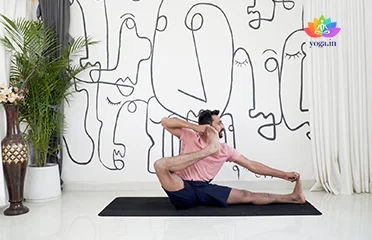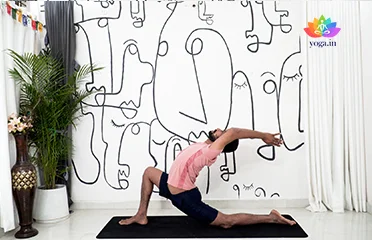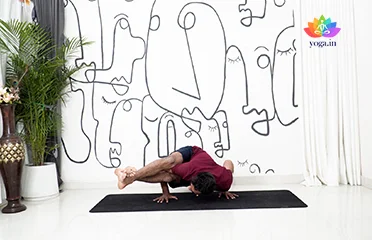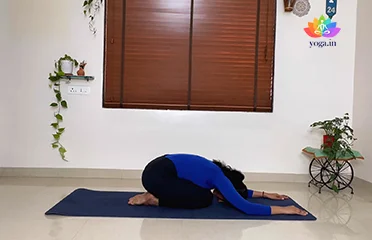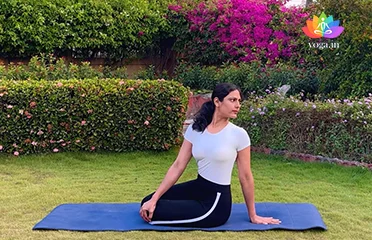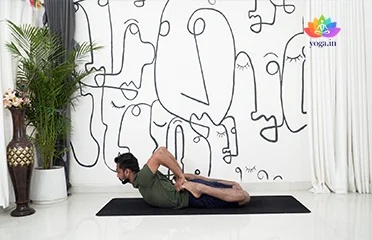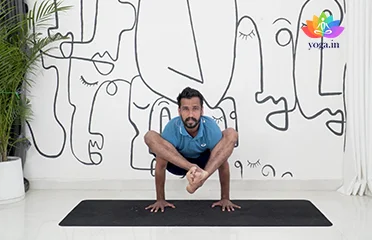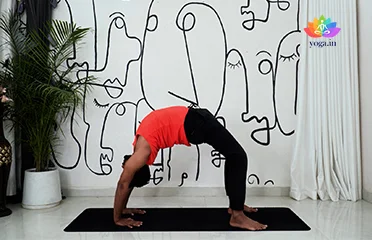Akarna Dhanurasana (Archer Pose)
अकर्णा धनुरासन / Archer Pose
The Sanskrit name is derived from Akarna (अकर्णा ) meaning towards [�K]
Anantasana (Sleeping Vishnu Pose)
अनन्तासन / Sleeping Vishnu Pose | Vishnu's Couch Pose
The Sanskrit name is derived from Ananta (अनन्त) meaning without end [�K]
Anjaneyasana (Crescent Moon Pose)
आंजनेयासन / Crescent Moon Pose
The Sanskrit name is derived from Anjane (आंजने) meaning Hanuman, [�K]
Astavakrasana (Eight-Angle Pose)
अष्टवक्रासन / Eight-Angle Pose
The sanskrit name is derived from ashta (अष्ट) meaning eight, Vakra [�K]
Balasana (Child’s Pose)
बालासना / Child's Pose
The Sanskrit name is derived from Bala (बाला) meaning child and āsana [�K]
Bharadvajasana (Seated Spinal Twist)
भरद्वाजसन / Seated Spinal Twist
The Sanskrit name is derived from Bhardvaja (भरद्वाज) means bringing [�K]
Bhekasana (Frog Pose II)
भेकासन / Frog Pose II
The Sanskrit name is derived from Bheka (भेका) meaning frog and asana [�K]
Bhujapidasana (Shoulder-Pressing Pose)
भुजपीडासन / Shoulder-Pressing Pose
The Sanskrit name is derived from Bhuja (भुज) meaning arm/shoulder, Pida [�K]
Chakrasana (Wheel Pose)
चक्रासनI / Wheel Pose
The Sanskrit name is derived from Chakra (चक्रा) means wheel and asana [�K]
Chaturanga Dandasana (Low Plank Pose)
चतुरङ्ग दण्डासन / Low Plank Pose
The Sanskrit name is derived from Chatur (चतुर) meaning four, Anga (अङ्ग) [�K]
- 1
- 2
- 3
How Yoga Can Help Cure Gastritis:
Gastritis is an inflammation of the stomach lining that can cause discomfort and pain. Yoga can play a significant role in managing and alleviating the symptoms of gastritis. Through specific postures, breathing exercises, and relaxation techniques, yoga can promote digestive health, reduce stress, and help soothe the stomach lining.
Understanding Gastritis:
Gastritis is a condition characterized by the inflammation of the stomach’s mucosal lining. It can be acute (sudden onset) or chronic (long-lasting). Common types of gastritis include erosive gastritis, which wears away the stomach lining, and non-erosive gastritis, which involves inflammation without erosion. Gastritis can lead to symptoms like nausea, vomiting, and a burning sensation in the stomach.
Yoga’s Role in Relieving Gastritis:
Specific yoga practices can help alleviate the symptoms of gastritis by enhancing digestion, reducing stress, and promoting overall well-being. These include gentle asanas (postures) that stimulate the digestive system, pranayama (breathing exercises) that calm the mind and body, and meditation techniques that reduce stress and promote healing.
Key Factors Contributing to Gastritis:
Several factors can contribute to the development of gastritis, including:
- Helicobacter Pylori Infection: A bacterial infection that can erode the stomach lining.
- Regular Use of Pain Relievers: Nonsteroidal anti-inflammatory drugs (NSAIDs) can irritate the stomach lining.
- Alcohol Consumption: Excessive alcohol intake can damage the stomach lining.
- Stress: Chronic stress can increase stomach acid production and cause inflammation.
- Bile Reflux: Bile from the small intestine backing up into the stomach.
- Autoimmune Conditions: The immune system attacking the stomach lining.
Symptoms of Gastritis:
Common symptoms of gastritis include:
- Abdominal Pain: A gnawing or burning pain in the upper abdomen.
- Nausea: A frequent feeling of wanting to vomit.
- Vomiting: Expelling stomach contents through the mouth.
- Bloating: Feeling full and bloated after eating.
- Loss of Appetite: Reduced desire to eat.
- Indigestion: Discomfort or pain in the stomach after eating.
- Black Stool: Indicating potential bleeding in the stomach.
Treatment of Gastritis through Yoga and Pranayama:
Yoga and pranayama can be highly effective in managing gastritis. Some beneficial practices include:
Specific Yoga Poses:
- Pawanmuktasana (Wind-Relieving Pose): Helps release gas and improve digestion.
- Marjariasana (Cat-Cow Pose): Stimulates abdominal organs and promotes digestion.
Pranayama Exercises:
- Anulom Vilom (Alternate Nostril Breathing): Balances the mind and reduces stress.
- Bhramari (Bee Breath): Calms the mind and reduces stress levels.
Diet for Gastritis:
A balanced diet can help manage gastritis. Recommendations include:
- Probiotic-Rich Foods: Yogurt, kefir, and sauerkraut support gut health.
- Fiber-Rich Foods: Fruits, vegetables, and whole grains aid digestion.
- Lean Proteins: Chicken, fish, and tofu provide essential nutrients.
- Anti-Inflammatory Foods: Ginger, turmeric, and green leafy vegetables reduce inflammation.
- Hydration: Drink plenty of water to stay hydrated and support digestion.
Caution for Gastritis:
While practicing yoga for gastritis, it is essential to:
- Avoid Overexertion: Practice at a gentle pace to prevent strain on the stomach.
- Be Mindful of Pain: Stop immediately if any pose causes discomfort or pain.
Always consult with a healthcare provider before starting any new exercise regimen, especially if you have severe gastritis.
Contraindications for Gastritis:
Individuals with severe gastritis or significant abdominal pain should:
- Avoid Intense Yoga Practices: Vigorous exercises might exacerbate symptoms.
- Steer Clear of Certain Poses: Inversions and poses that compress the abdomen may increase discomfort.
- Seek Professional Guidance: Consult a yoga therapist or healthcare professional for personalized recommendations.


